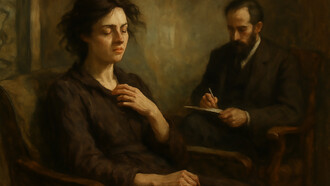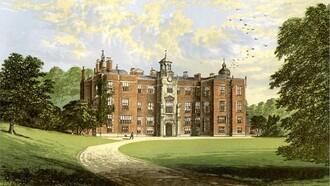Whoe’er she be,
That not impossible she,
That shall command my heart and me.(Richard Crashow)
From Zeus to Bezos, powerful men valued the wisdom of their wives and mistresses, some of whom had just as much influence on the political and cultural scene. Writers, painters, and musicians called them ‘muses,’ the inspiration and subject of many artistic masterpieces.
Historically, the title of ‘mistress’ (shortened to Mrs.) was applied to all adult women of higher social status, whether married or single. Derived from the Latin magister (master, or teacher), it denotes a woman in a position of power and control, as part of her professional life or in a given situation. Recently, the term acquired the more limited meaning of a woman who is in a relationship with a married man. The civic status of the woman is not relevant; she may or may not be married herself.
We are fascinated by the mistresses of kings and high office men, considered ‘the power behind the throne.’ A list of royal mistresses, by country and in alphabetical order, records—chronologically—an impressive number of prestigious names. Many were the mothers of royal children; some changed their status to ‘wife,’ and nearly all influenced the artistic, cultural, and even political scene of their time. The work of their contemporary portraitists enables us to imagine the beauty parameters of that time.
French royalty in particular, from Charlemagne to Chirac, has gained a reputation for extravagant love lives. Enter the glittering corridors of the Louvre, where gossip, conspiracies, and intrigue decided the lives of young courtiers and powerful officials and through them, the fate of the nation.
If in today’s democratic world the appointment of a former mistress to an official capacity would cause a media storm, there were not many eyebrows raised when kings took political and diplomatic advice from their female companions. In some cases, she was the only person at court the king could trust.
Beauty, wit and charm
The first officially recognised royal mistress was the young Agnès Sorel. With her pale blue eyes and porcelain skin, Charles VII’s mistress was apparently the most beautiful woman that anyone has seen. Her portrait by Jean Fouquet on the Melun Diptych features the young mistress as the nursing virgin (Virgo lactans), wearing the low-cut, front-opening gown fashionable at the time (’through which one sees the teats, nipples, and breasts of women," as described by a scandalised archbishop of Reims). The long ermine cloak is a reference to her taste for luxury, and the crown indicates her position at the court. Agnès had a positive influence on King Charles VII of France, helping him out of a long depression. It is believed that she was the one who convinced the king to rally his army and defend France against the English.
Once the title of maîtresse-en-titre was established, a new role was open for unofficial mistresses (petite maîtresse). Henry IV allegedly had 29 unofficial mistresses in addition to his two official ones; this apparent record was soon overtaken by Louis XV with six official and more than 50 unofficial mistresses.
The power of love
One of the strongest women in French history was Diane de Poitiers, mistress of Henry II. Twenty years his senior, she exercised major influence on the French king, thanks to the combination of her thirst for power and his devoted love.
When she was 15 years old, Diane was married to Agnès Sorel’s grandson (the French court was a restricted club) and had two daughters. After the death of Henry’s mother, Diane became his governess. At 31 she became a widow and—unusually for the time—took over her husband’s estate. She demonstrated a special talent for managing the inherited assets, with great attention to financial detail, and became a real businesswoman. Dressed always in black and white (the mourning colours) and a striking beauty, she assumed a very influential position at court. Even more so when, a year after Henri’s marriage to Catherine de Medicis, Diane became his mistress, an affair that was to last 25 years.
A wealthy woman, Diane financed several construction projects. She was patron of Renaissance architect Philibert de l’Orme, who supervised the building of, among others, Château de Chenonceau, Château de Vincennes, and modernisation of Palace of Fontainebleau. Beyond the architectural heritage, Diane de Poitiers lives on in novels, films, and TV series.
A taste for luxury
The most famous (as well as infamous) mistress of Louis XV was the beautiful, intelligent, and educated Madame de Pompadour. By the time she met the king, Jeanne Antoinette (as she was then known) had already charmed the salons of Paris with her grace and wit. She held her own salon, which was frequented by members of the cultural, political, and artistic elite. Interested and informed about art, music, philosophy, and literature, she was influential in securing royal patronage for painters and writers of the Enlightenment.
In particular, Madame de Pompadour loved porcelain: elegantly crafted and decorated in sumptuous colours (bleu lapis, bleu celeste, pink, and gilding) delicate, yet a symbol of power; fragile, yet enduring. In 1745, when she became Louis XV’s maîtresse-en-titre, the porcelain factory at Vincennes was allowed unique privileges; a law was passed which forbid the manufacture of porcelain by anyone else. Later, the factory moved to Sèvres, close to Madame de Pompadour’s chateau de Bellevue.
Several portraits by Francois Boucher, commissioned by the marquise, testify to her beauty and sense of style: luxuriously dressed, coiffed, and accessorized. We see her hand holding an open book, or resting on the keyboard; in the picture, a leather-bound book with her coat of arms on the cover signifies wealth, while a globe refers to her extensive education and interests. When the love affair with Louis XV ended, around 1751, she became the king’s friend and confidant and astutely forged a good relationship with the queen, becoming her lady in waiting—the most prestigious position for a woman at court.
There are many people at Versailles today.
This bland remark was the first words Marie Antoinette addressed to Jeanne Bécu, Countess du Barry, four years after Jeanne became Louis XV's mistress, during which time the dauphine totally ignored her. Of humble origins, Jeanne worked as an assistant milliner, a grisette, and a courtisane before becoming the king’s maîtresse-en-titre. Although it was said she was more interested in fashion and jewellery than in politics, Jeanne was a supporter of arts and crafts and a close friend of the writer Voltaire. She commissioned furniture by Louis Delanois and Jean-Francois Leleu, helping to boost the popularity of neoclassical style.
‘A ray of sunshine’ for the ageing king (33 years her senior) Madame du Barry remained loyally at the king’s side until his death. Receiving a gift of a young Bengali slave known as Zamour, Madame du Barry took a liking to him, treated him to a lavish lifestyle at Versailles, and arranged for him to receive a good education. However, in 1792 Zamour testified against her; his accusations led to her arrest, charges of treason, and finally the blade of the guillotine. Her final words, as famous as Marie Antoinette’s utterances, were, ‘One more moment, Mr. Executioner, I beg you.’















